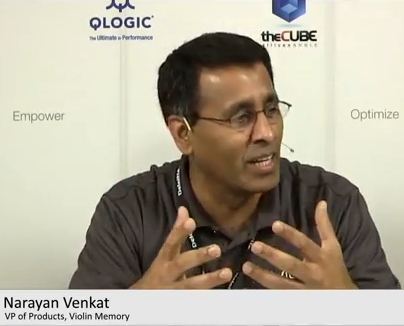 NEWS
NEWS
 NEWS
NEWS
 NEWS
NEWS
![]() theCUBE co-hosts Dave Vellante and David Floyer sat down with Violin Memory VP of Production Narayan Venkat to discuss the world of flash. Floyer, the co-Founder and CTO of research firm Wikibon, has extensive expertise in the flash sector, and one of his recent studies showed that optimizing your infrastructure stack and spending money on storage (specifically Flash storage) can result in reducing the number of cores that you deploy to support applications.
theCUBE co-hosts Dave Vellante and David Floyer sat down with Violin Memory VP of Production Narayan Venkat to discuss the world of flash. Floyer, the co-Founder and CTO of research firm Wikibon, has extensive expertise in the flash sector, and one of his recent studies showed that optimizing your infrastructure stack and spending money on storage (specifically Flash storage) can result in reducing the number of cores that you deploy to support applications.
For Oracle customers, that’s important because “the largest single component of any system running Oracle is the Oracle licence itself,” Floyer explained. “If you can optimize on the numbers of cores that you need, using flash as a Tier, then the net effect of that is that a whole lot of processes that you would do waiting for I/O goes away, and you require far fewer cycles – in the order of 40-50 percent less – needing less Oracle licences to do your work. This allows for improvement on that environment,” said Floyer.
It was then the discussion moved to Venkat, speaking on the process of moving the Oracle data sets and applications in memory.
“We’ve been preaching that for quite some time; if you move the bulk of your business critical applications in the system memory, you can achieve tremendous amount of application acceleration and, as a result, business acceleration too,” said Venkat. “That is exactly what Violin has been doing for the last five years.”
“At this event, Violin Memory is taking the opportunity to demonstrate a plethora of solutions in the memory array, flash memory, persistent storage running on the network, but we’re also demonstrating flash memory acceleration on the server side with a PCI card, as well as demonstrating a solution Maestro Services Software Suite that enables you to pull data from applications that are running on legacy storage, helping you move them over to persistent memory base tier,” declared Venkat.
One of the recent trends is moving toward a world with no disks. For Violin Memory, that is a more tangible vision compared to the capabilities of its competitors. Vellante asked Venkat to elaborate on the concept of In-Memory.
“It’s well understood among end-users and practitioners that if you can move your applications sets – or the hot data – in-Memory, and I say that in a broad sense, you can certainly accelerate the applications.”
On the other hand, it’s well known that the amount of processed data sets is much larger than the active data sets. “If you have a broader tier of memory – some of it is non-persistent and some in-Memory, and you stay away from using (spinning) disks as means for persisting data, then, at scale, you can achieve tremendous economics and business acceleration,” said Venkat.
![]()
Last week Violin Memory announced its new complementary software called Maestro Services Software Suite, which incorporates technologies from acquired companies as well as technology developed in-house. The result allows clients to tier applications data between disk storage systems resident on the network, while incorporating a memory tier.
“You can use this tiered data in multiple ways; as a platform of accelerating read-only data (cache), or a broader scheme in terms of tiering, where both read-only and write data are stored in the persistent memory,” said Venkat. “We believe the solution to be an on-ramp to help you move your data sets from legacy spinning disks storage architectures to a persistent memory architecture.”
Apart from the seamless, non-disruptive process, the suite can easily be removed if need be, once the data has been migrated from the legacy architecture to the new architecture.
As David Floyer put it, “Oracle databases tend to be the mission-critical applications in organizations, and people are very reluctant to take any sort of risks with that.” In this respect, Floyer wanted to know how to overcome this impediment, and how Violin Memory convinces a CIO to let them help with the step-by-step migration.
“We’ve been going into primary database workloads – so think mission/business-critical environments – wherein our customers have been using our memory arrays as a backend repository for their database workloads,” Venkat explained.
“We’ve been very successful in the market already, for the past several years, running those business-critical databases on our memory arrays. Our memory arrays are highly available, they are designed for tier 1 workloads, they have a tremendous amount of redundancy built in. We have a large number of customers deploying these today, which is a proofpoint of what we’ve been bringing into this market,” concluded Venkat.
THANK YOU